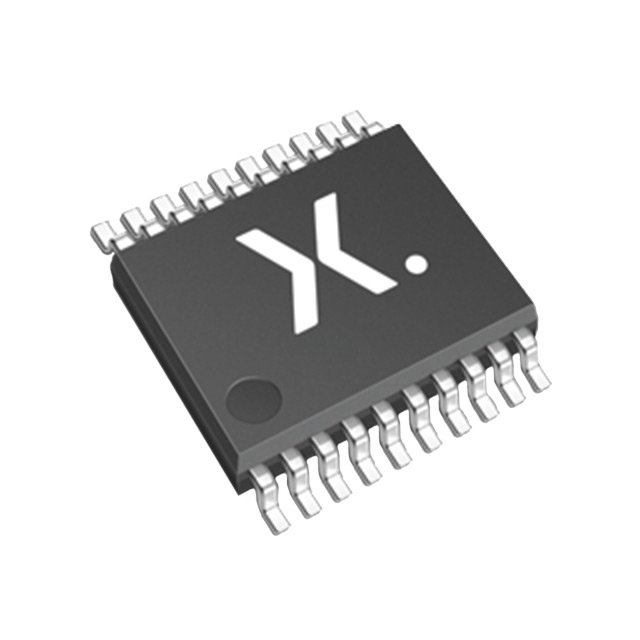74LVC541APW-Q100J
Basic Information Overview
- Category: Integrated Circuit (IC)
- Use: Logic Level Shifter
- Characteristics: Low Voltage CMOS Octal Buffer/Line Driver with 5V Tolerant Inputs and Outputs
- Package: TSSOP (Thin Shrink Small Outline Package)
- Essence: This IC is designed to shift logic levels between different voltage domains, allowing compatibility between devices operating at different voltage levels.
- Packaging/Quantity: The 74LVC541APW-Q100J is typically sold in reels or tubes containing a specific quantity of ICs.
Specifications
- Supply Voltage Range: 1.2V to 3.6V
- High-Level Input Voltage: 0.7 x VCC
- Low-Level Input Voltage: 0.3 x VCC
- High-Level Output Voltage: VCC - 0.4V
- Low-Level Output Voltage: 0.4V
- Maximum Operating Frequency: 80 MHz
- Number of Channels: 8
- Input/Output Compatibility: 5V Tolerant
Detailed Pin Configuration
The 74LVC541APW-Q100J has a total of 20 pins. The pin configuration is as follows:
+---+--+---+
OE -|1 +--+ 20|- VCC
A1 -|2 19|- B1
A2 -|3 18|- B2
A3 -|4 17|- B3
A4 -|5 74LVC541APW-Q100J 16|- B4
A5 -|6 15|- B5
A6 -|7 14|- B6
A7 -|8 13|- B7
GND -|9 12|- B8
A8 -|10 11|- OE#
+-----------+
Functional Features
- Logic Level Shifting: The IC allows for the translation of logic levels between different voltage domains, enabling communication between devices operating at different voltage levels.
- Buffer/Line Driver: It can be used as a buffer or line driver to amplify and transmit digital signals.
- 5V Tolerant Inputs and Outputs: The IC is designed to tolerate 5V input and output signals, making it compatible with both 3.3V and 5V systems.
Advantages and Disadvantages
Advantages: - Wide supply voltage range allows compatibility with various systems. - 5V tolerant inputs and outputs provide flexibility in interfacing with different voltage levels. - High-speed operation with a maximum frequency of 80 MHz. - Octal configuration provides multiple channels for signal transmission.
Disadvantages: - Limited number of channels (8) may not be sufficient for complex systems requiring more connections. - TSSOP package may require careful handling during soldering due to its small size.
Working Principles
The 74LVC541APW-Q100J operates by receiving input signals from one voltage domain and translating them to the corresponding logic levels of another voltage domain. It utilizes CMOS technology to achieve low power consumption and high-speed operation. The inputs and outputs are designed to tolerate 5V signals, allowing for compatibility with both 3.3V and 5V systems.
Detailed Application Field Plans
The 74LVC541APW-Q100J finds applications in various fields where logic level shifting and signal buffering are required. Some potential application areas include: - Microcontroller interfacing with different voltage peripherals. - Communication interfaces between devices operating at different voltage levels. - Level shifting in battery-powered devices with low power consumption requirements.
Detailed and Complete Alternative Models
- 74LVC245APW: Octal Bus Transceiver with 3-State Outputs
- SN74LVC1G07DCKR: Single Buffer/Driver with Open-Drain Output
- 74HC541N: Octal Buffer/Line Driver with 3-State Outputs
These alternative models offer similar functionality to the 74LVC541APW-Q100J and can be considered as alternatives based on specific application requirements.
Word count: 452 words
قم بإدراج 10 أسئلة وإجابات شائعة تتعلق بتطبيق 74LVC541APW-Q100J في الحلول التقنية
Sure! Here are 10 common questions and answers related to the application of 74LVC541APW-Q100J in technical solutions:
Q: What is the 74LVC541APW-Q100J? A: The 74LVC541APW-Q100J is a high-performance octal buffer/line driver with 3-state outputs, designed for use in various digital applications.
Q: What is the operating voltage range of the 74LVC541APW-Q100J? A: The operating voltage range of the 74LVC541APW-Q100J is typically between 1.65V and 5.5V.
Q: How many inputs and outputs does the 74LVC541APW-Q100J have? A: The 74LVC541APW-Q100J has 8 inputs and 8 outputs.
Q: What is the maximum output current of the 74LVC541APW-Q100J? A: The maximum output current of the 74LVC541APW-Q100J is typically 32mA per output.
Q: Can the 74LVC541APW-Q100J be used for level shifting between different voltage domains? A: Yes, the 74LVC541APW-Q100J can be used for level shifting as it supports bidirectional voltage translation.
Q: Is the 74LVC541APW-Q100J compatible with both TTL and CMOS logic levels? A: Yes, the 74LVC541APW-Q100J is compatible with both TTL and CMOS logic levels.
Q: Does the 74LVC541APW-Q100J have built-in protection features? A: Yes, the 74LVC541APW-Q100J has built-in protection features such as overvoltage and undervoltage lockout.
Q: What is the maximum propagation delay of the 74LVC541APW-Q100J? A: The maximum propagation delay of the 74LVC541APW-Q100J is typically 5.4ns.
Q: Can the 74LVC541APW-Q100J be used in automotive applications? A: Yes, the 74LVC541APW-Q100J is specifically designed for automotive applications and meets the AEC-Q100 qualification requirements.
Q: Are there any recommended application circuits available for the 74LVC541APW-Q100J? A: Yes, the datasheet of the 74LVC541APW-Q100J provides several recommended application circuits that can be used as a reference for different use cases.
Please note that these answers are general and may vary depending on the specific requirements and conditions of your technical solution. It's always recommended to refer to the datasheet and consult with the manufacturer for detailed information and application-specific guidance.


